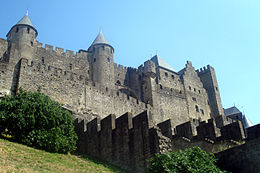Cité de Carcassonne
| UNESCO World Heritage Site | |
|---|---|
 | |
| Criteria | Cultural: ii, iv |
| Reference | 345 |
| Inscription | 1997 (21st Session) |

The Cité de Carcassonne is a medieval fortified architectural group located in the French city of Carcassonne, in the department of Aude, in the region of Languedoc-Roussillon. It is located on the right bank of the Aude, on the hill, in the south-east part of the actual city. It was the historic city of Carcassonne.
The Cité de Carcassonne was founded in the Gallo-Roman period. It derives its reputation from double surrounding walls (3 km in length) with 52 towers.[1] The town has about 2,500 years of history: it has seen the Romans, Visigoths, Saracens and Crusaders. In the beginning of its history it was a Gaulish settlement. In the 3rd century A.D., the Romans decided to transform it into a fortified town.[2] The town was finally annexed to the kingdom of France in 1247 A.D. It was a strong French frontier between France and the Kingdom of Aragon.
In 1659, after the Treaty of the Pyrenees, the province of Roussillon became a part of France, and the town lost its military significance.[3] Fortifications were abandoned and the town became one of the economic centres of France, concentrating on the woollen textile industry.
In 1849 the French government decided that the city fortifications should be demolished. This decision was strongly protested by the masses. Jean-Pierre Cros-Mayrevieille and Prosper Mérimée, an eminent archaeologist and historian, led a campaign to preserve the fortress as a historical monument. The government reversed its decision and in 1853 restoration work was started. Eugène Viollet-le-Duc, the architect, was charged with renovating the fortress.[4] Viollet-le-Duc's work was criticised during his lifetime as inappropriate to the climate and traditions of the region. After his death in 1879, the restoration work was continued by his pupil, Paul Boeswillwald, and later by the architect Nodet.[5]
The town was restored at the end of the 19th century. In 1997 it was added to UNESCO's list of World Heritage Sites.[6][7]
References
- ^ Les lieux remarquables de la Cité, Site Officiel de la ville de Carcassonne. Retrieved 12 May 2011 Template:Fr icon
- ^ Jean-Pierre Panouillé, Carcassonne: histoire et architecture, Rennes: Ouest-France, 1999, ISBN 978-2-7373-2194-8, p. 7 ((fr icon))
- ^ François de Lannoy, La Cité de Carcassonne, Bayeux: Heimdal, 2004, ISBN 978-2-84048-197-3, p. 11 Template:Fr icon
- ^ Joseph Poux, La Cité de Carcassonne, précis historique, archéologique et descriptif, Toulouse: Privat, 1923, p. 50 Template:Fr
- ^ Carcassonne, A61 world heritage fortified city – Abelard Public Education Site.
- ^ Historic Fortified City of Carcassonne at the World Heritage Convention.
- ^ Château et remparts de la Cité de Carcassonne – Centre des monuments nationaux, Monuments historiques (English version). Retrieved 12 May 2011.
External links
- French Ministry of Culture site on the Cité of Carcassonne, with history and virtual tour (English version available)
- Mescladis, a site about Carcassonne, the Cité and the Bastide Saint-Louis – history and architecture
- Le Château de Carcassonne at chateauxmedievaux.com, with numerous pictures Template:Fr icon
